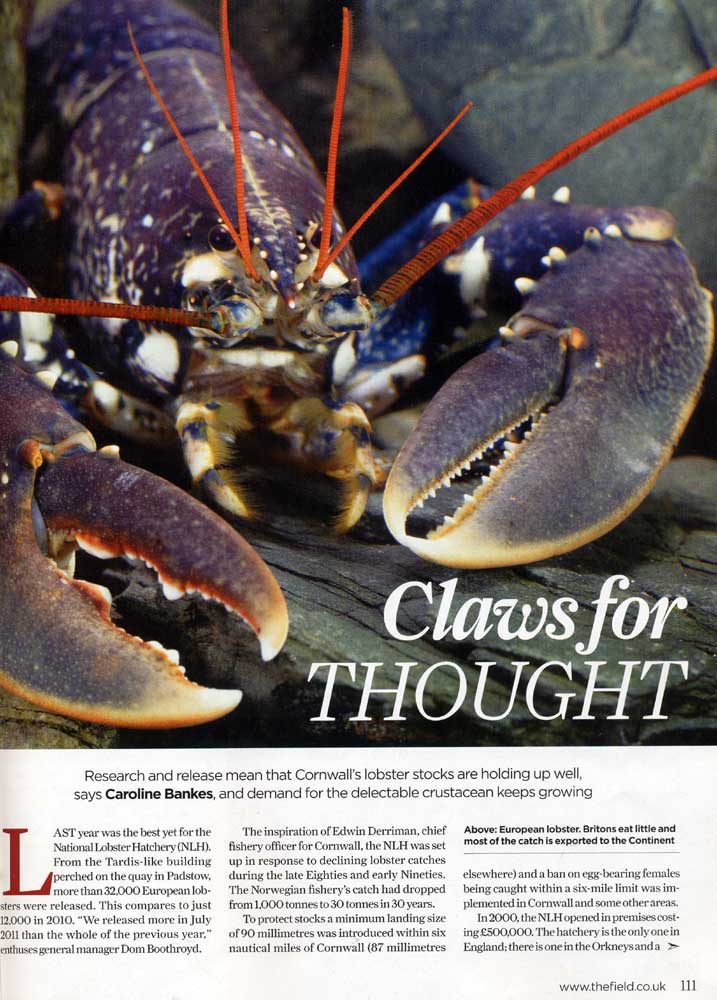LATEST
NEWS:
30
September 2012
Young
Fin Whale
Photographs
by John Cox
A
member from the Zoological
Society of London (ZSL) taking samples
for the post mortem
Another
Fin
Whale, Balaenoptera
physalus, has become a casualty washed up
dead on the east coast of England at Shingle
Street,
near Hollesley, Suffolk,
in the afternoon. The juvenile female whale was 9.8 metres in length and
did not appear to be injured.
A young
Sowerby's Beaked
Whale, Mesoplodon bidens,
was washed ashore alive at the beach
near Auburn Farm, near Bridlington,
Yorkshire. However, the 3.37 metre long whale was very ill with a bacterial
infection and beaching injuries, and after unsuccessful rescue attempts
it had to be euthanised.
The young whale would have weighed about half a tonne.
Previous
Beaked Whale Report 2012
British
Divers Marine Life Rescue
26
September 2012
Another Sei
Whale, Balaenoptera
borealis, was washed ashore, this
time in Northumberland
on the north-east coast of England. It came ashore on the sandy beach at
Druridge
Bay,
(seven miles wide from Amble
in the north to Cresswell
in the south). The 8.6 metres long whale was
extremely thin and too malnourished to be refloated and to any chance of
survival, so it was euthanised.
14
September 2012

Stranded Sei
Whale
Photograph
by Toxic Web
Another
baleen
whale was washed up dead on a beach on the east coast of Scotland.
This time it was a large 13 metre long Sei
Whale, Balaenoptera
borealis, discovered on the sandy
beach at Elliot,
Arbroath,
around 8.30 am.
6
September 2012
As
the sun rose above the ocean on the edge of the continental
shelf off south-west Ireland (on the Porcupine
Bight, west of Dursey
Island in County
Cork), the team on the Irish
Whale and Dolphin Group's new marine research
vessel Celtic Mist
were greeted by several Fin Whales,
Balaenoptera
physalus, and
shortly afterwards had the amazing opportunity to witness two Blue
Whales, Balaenoptera
musculus, surface within 500 metres
of the boat. This is only the third discovery of Blue
Whales off Ireland on a week long trip in
which eleven cetacean species were recorded.
BMLSS
Cetaceans
Bathymetry
(British Isles)
2 September
2012
An
extremely unusual of an angling capture of a Long-billed (Atlantic) Spearfish,
Tetrapturus
pfleuger, off a beach known as the Knap,
Barry
Island, south Wales, was the first known
record of this tropical pelagic fish in British seas.
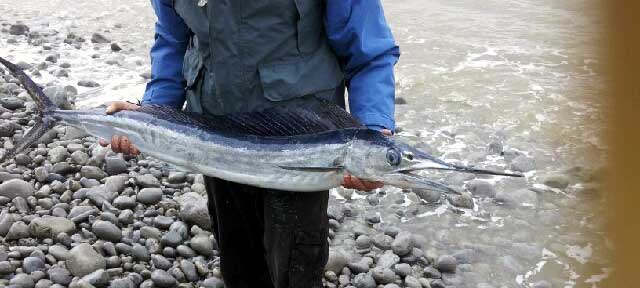
"This
fish was caught around 1 hour 45 minutes after high water, The fish was
very clean an lively an even had a sticky fish stuck to it. It was then
put back alive but wasn't very strong so I got in the sea to help it out.
It the swam off alive, minus the sucker fish which I lost."
Sea
View Lads Angling Club
2
September 2012
Pilot Whale Stranding
Photographs
by Jacqui Hetherington
A mass
stranding of 26 Long-finned Pilot
Whales, Globicephala melas, was
discovered at the foot of the steep cliffs at Pittenweem
(near Anstruther),
Fife,
east Scotland, at
7.10 am
in the morning. Thirteen of the Pilot Whales
which were already dead and probably only nine of the remaining animals
were likely to survive. The survivors were being attended to by the medics
and volunteers of British
Divers Marine Life Rescue. At mid
morning, reports came in of another 24 Pilot
Whales in the shallows three miles along the
coast at Cellardyke
on the north coast of the outer Firth
of Forth. By the late afternoon
three of the surviving whales
perished, but ten of them swam off strongly into open water on the high
tide,
two of them with help from the human volunteers to join the pod as they
had stranded again.
One
of the surviving Pilot Whales
subsequently died but the other survivors joined the rest of the pod and
were seen further up the Firth of Forth possibly feeding on shoals of squid
reported in the area.
On 9
September 2012 a Pilot
Whale calf was washed up dead. This calf may
have been dependent on its mother who became beached and died.
Pilot
Whale Stranding & Rescue in 2011
BMLSS
Cetaceans
24
August 2012
An
exceptionally large 7 kg (15 lb 4 oz) European
Lobster, Homarus
gammarus, was found by divers, Mark
Corp and Mark Reed, and donated to the Blue
Reef Aquarium at Portsmouth.
It appears to be the largest and heaviest Lobster
caught off the British coast since 1931.
BMLSS
Lobsters
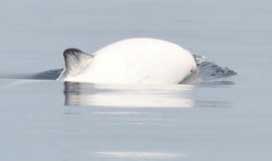 A
very rare leucistic all white Harbour
Porpoise, Phocoena phocoena, was
photographed in the Moray
Firth, off NE Scotland.
A
very rare leucistic all white Harbour
Porpoise, Phocoena phocoena, was
photographed in the Moray
Firth, off NE Scotland.
A
Porbeagle Shark,
Lamna
nasus, is discovered dead on the sand of Filey
Beach, Yorkshire.
BMLSS Sharks
15
-16 August 2012
A
young Sowerby's Beaked
Whale, Mesoplodon bidens,
was washed up alive but in distress at Aust
near the First Severn
Crossing. The 2.7 metre long beaked whale
calf became beached at about 10:00
pm and was euthanised
by a vet at about 3:30 pm
on the second day.
"The
beaked
whale calf should have been with its mother.
If we had managed to refloat the animal it would have starved to death
because its mother wasn't anywhere near and the likelihood of them finding
each other was limited," said the vet
Elspeth
Hardie.
Beaked
Whales are an elusive deep water whales which
are rarely seen around the British Isles.
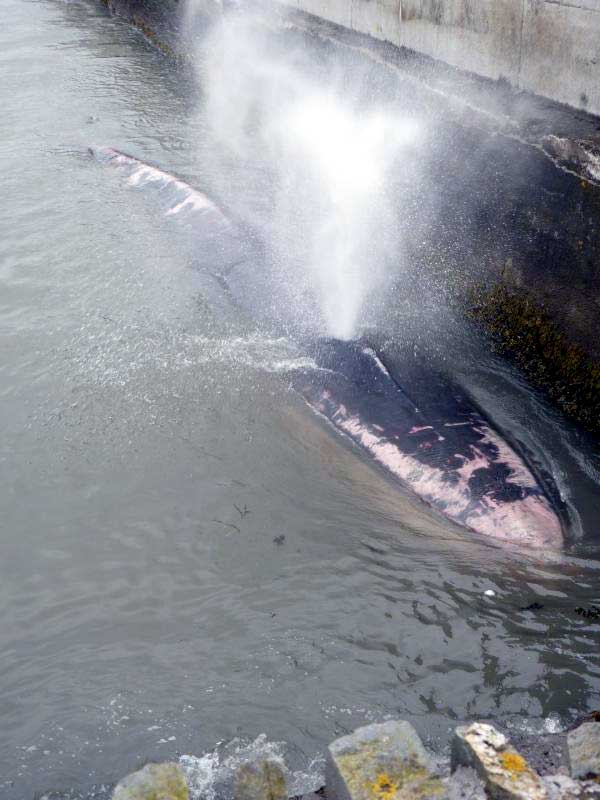 |
14
August 2012
An
18 metre long Fin Whale, Balaenoptera
physalus, swam into Baltimore
Harbour,
County
Cork, early in the morning and stayed virtually motionless at
the bottom of the pier all day. Fishermen tried to coax the huge mammal
back into open water without success. As crowds of people arrived to watch,
experts realised that the whale must be ill to behave in such a strange
manner.
Pádraig
Whooley (IWDG) said
"the whale’s behaviour suggested it was very unwell and would almost certainly
die. If this was a healthy whale she could probably reverse out of harbour.
It looks somewhat emaciated, and thrashing throughout the night has caused
some injuries."
The
whale
died in the harbour on 15 August 2012.
Irish
Whale & Dolphin Group (IWDG)
IWDG
Facebook Discussion
Whales
& Dolphins in British Seas |
Fin
Whale blowing, trapped in Baltimore Harbour
Photograph
by Keith Kingston
13
August 2012
An
unusual
report was received of a tropical Smalltooth Sandtiger
Shark, Odontaspis
ferox*, washed up on the southern
coast the English Channel (la Manche) and found alive on the sandy shore
at Agon-Coutainville
on the Cherbourg
Peninsula (west coast). (So extraordinary
was this report that I did not include it until the identity of the fish
could be verified.) The 2.5 metre long shark,
weighing in excess of 200 kg was pushed back into the sea and was not recovered
for identification.
(*probable
ID only, not verified.)
Discussion
on the Marine Wildlife of the NE Yahoo Group
Smalltooth
Sandtiger Sharks have been caught at widely
scattered locations throughout the world, indicating a possibly circumtropical
distribution. In the eastern Atlantic Ocean, it is known from the Bay of
Biscay south to Morocco, including the Mediterranean Sea, the Azores, and
the Canary Islands.
BMLSS
Sharks
BMLSS
Shark News
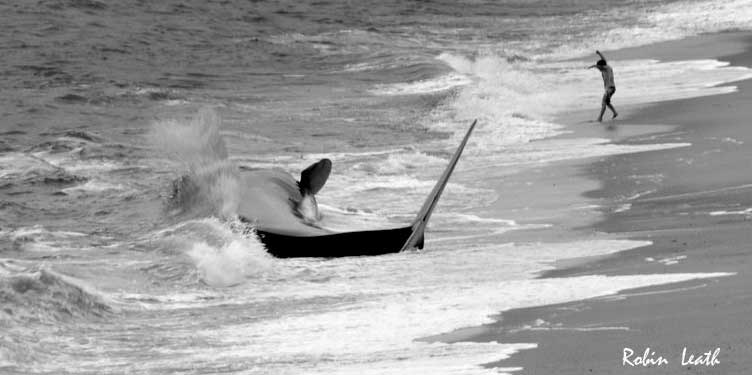
Fin Whale floundering
in the surf at Carlyon Bay
Photograph
by Robin Leath
The
photograph was taken at a vantage point some 250 metres from the Fin
Whale and about 20 metres above it. The whale
was still alive at the time of this shot, but floundering heavily and probably
suffocating under its own immense weight in the surf along the Carlyon
bay beach, Cornwall.
A badly
injured fully grown 19 metre long Fin Whale,
Balaenoptera
physalus, was washed ashore at CarlyonBay
on the south coast of Cornwall
two miles east of St.
Austell. The live whale
was is such a poor condition that it had to be euthanised.
BMLSS
Cetaceans
IUCN
Red List Entry of a threatened species.
BMLSS
Strandings Page

The UK
Cetacean Strandings Investigation Programme (CSIP) has been running
since 1990 and is funded by Defra and the Devolved Administrations. They
co-ordinate the investigation of all whales, dolphins and porpoises (collectively
known as cetaceans), marine turtles and basking sharks that strand around
the UK coastline.
|
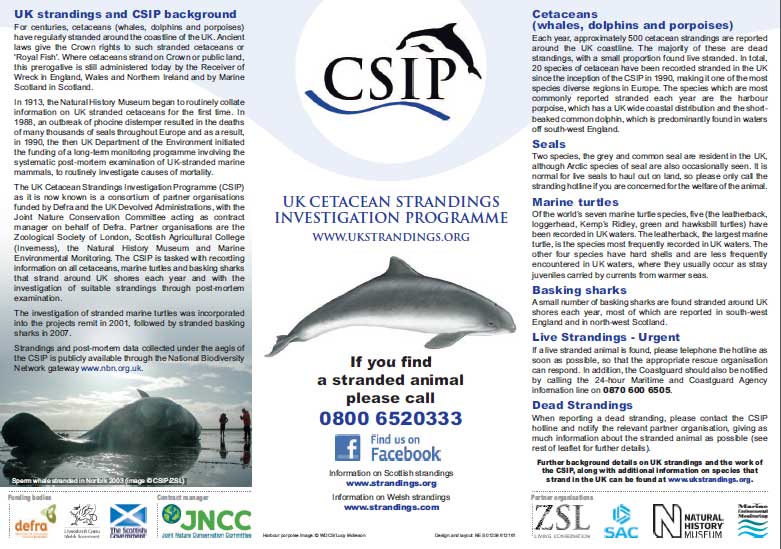
Stranded
Animal Call Line: 0800 6520333
|
More
Stranded Animal Report Numbers (Link)
10
August 2012
.jpg)
Rockpooling
Event at the Old Fort organised by the
Friends
of Shoreham Beach (FOSB)
Over
150 rockpoolers descended down on to the
safe beach at Old
Fort, Shoreham
Beach at low tide and they were able to forage
in the pools for over two hours. The critters of the seashore
never had a chance to escape the flimsy nets and probing fingers of the
youngsters. Fish fry swam in the shallow pools, notably scores of the young
of the
Two-spotted Goby, Gobiusculus
flavescens. Many of the captures were decamped
to temporary aquariums further of the beach
and returned to the pools before the incoming tide. Other notable captures
included a juvenile Greater Pipefish, Syngnathus
acus, looking like a thin strip of seaweed
until it wriggled, juvenile flatfish including two small Plaice,
Pleuronectes
platessa, with more escaping the nets,
the first intertidal Solenette
(Slipper
Sole),
Buglossidium
luteum, and the expected mixture of
Bass
fry,
Dicentrarchus
labrax, small prawns
and shrimps, tiny Bullheads,
Taurulus
bubalis, Shore
Crabs,
Carcinus
maenas, of all sizes and colours and
the common intertidal molluscs.
FOSB
Events
BMLSS
Rockpooling
7 August
2012
A
most extraordinary encounter occurred between a 10 metre long juvenile Humpback
Whale, Megaptera novaengliae, and
a fishing vessel of a similar length out of Whitby,
Yorkshire.
"The
whale suddenly appeared and started rubbing against the boat, swimming
under and around us and then rubbing its belly on the boat. It stayed for
about 20 minutes, and when we had to move on it went over to the Mistress
which was fishing about half a mile away. They radioed to say it was doing
exactly the same to their boat,” said
Sea Otter 2 skipper
Paul Kilpatrick.
"It
sounds as though it was trying to bond. Rubbing its belly on the boat mimics
suckling behaviour of a calf towards its mother,” said Robin
Petch of the Sea
Watch Foundation. “I have grave
worries for this youngster. My hope is that it has been reunited with its
mother, but if it has become lost, or the mother has perished, it would
be very unlikely to survive for very long.”
The
knobby head and long pale flippers identified this cetacean as the Humpback
Whale rather than the Minke
Whale, Balaenoptera acutorostrata,
of which the fishermen were familiar with in the North Sea.
Sea
Watch Foundation Sightings Page
BMLSS
Cetacea
4 August
2012
In
living memory the Thresher
Shark,
Alopias
vulpinus, was if not a regular sighting
off the Sussex coast,
it would be remarkable because of its exceptionally long caudal fin. Now,
a Thresher Shark
is a newsworthy event caught by a boat angler out of the notable shark
fishing centre of Looe,
south Cornwall. The
shark was landed and released.
Three
species of Thresher Shark
have been declared to be "vulnerable", according to the International
Union for Conservation of Nature and Natural Resources (IUCN)
IUCN
Red List of a threatened species.
Link
to an Image
of a Thresher Shark (jumping out of the water) from Cardigan Bay,
Wales
Why
Thresher Sharks have huge caudal fins (BBC)
BMLSS
Sharks
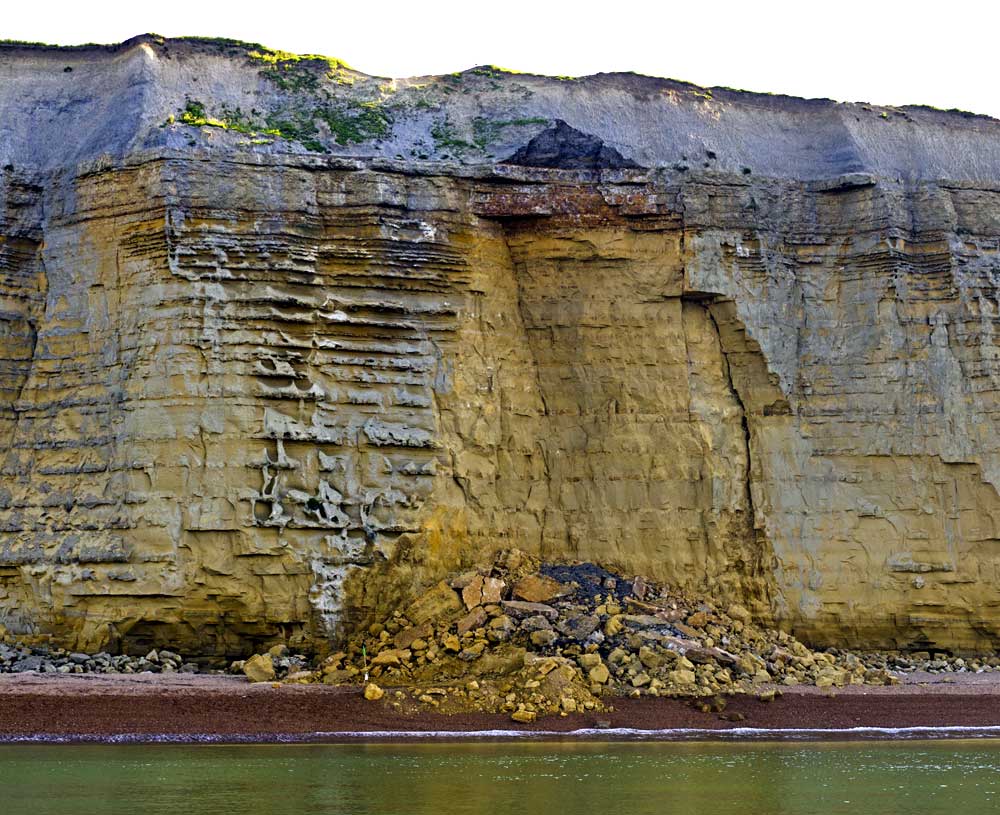
Cliff
Fall at Burton Bradstock
Photographs
by Graham Wiffen
Graham
Wiffen Photography

Graham
Wiffen Seascapes
23
July 2012

A juvenile
Basking
Shark,
Cetorhinus maximus,
was observed swimming in very shallow water (swimming amongst bathers!)
at the coastal town of De
Panne (Belgium). It’s length was estimated at around two metres, and
it could be identified through the photographs provided by deputy-chief
lifeguard Filip Jongbloet.
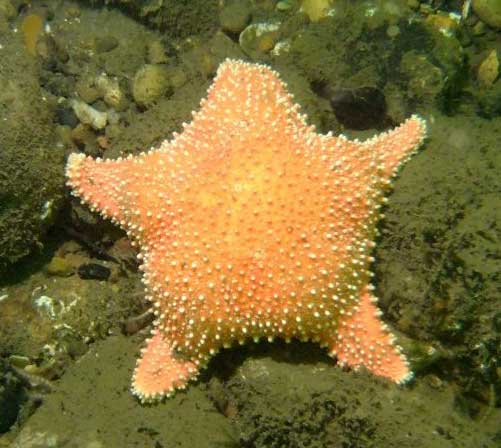 15
July 2012
15
July 2012
An
Arctic Rigid Cushion Star, Hippasteria
phrygiana,
was spotted on a dive off the Northumberland
coast
in the proposed Marine
Conservation Zone between Coquet
and St Mary’s. This northern species is
one of only two records off an English coast. It usually inhabits the seas
off Greenland
and all over the northern Atlantic although
it it is present in the seas around the Shetland
Isles and it has been trawled
off St. Abbs further north on the same North
Sea coast. This
cushion
star
was around 10 cm across and was recorded
at 20 metres depth on a cobble/pebble seabed.
Marine
Conservation Zone Project Interactive Map
BMLSS
Echinoderms
4 July
2012
Several
fisherman have reported seeing a dead and decaying Loggerhead
Turtle,
Caretta
caretta, about a metre and a half long to the east of the island
of Herm
in the Channel Islands.
There are no records of a live individual of this species has ever been
reported from the Channel Islands area. Occasional
turtles have been seen before though.
BMLSS
Turtles

British
Marine Life News 2011
Cornish
Marine Life Records 2009
BMLSS
Oil Disasters page



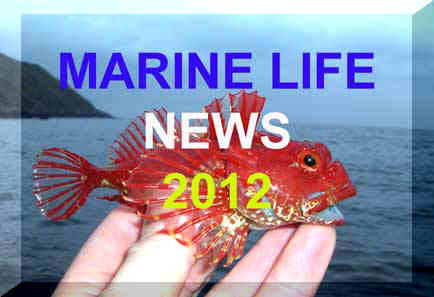









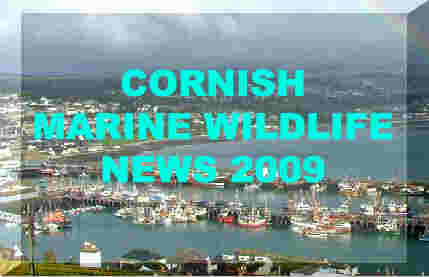

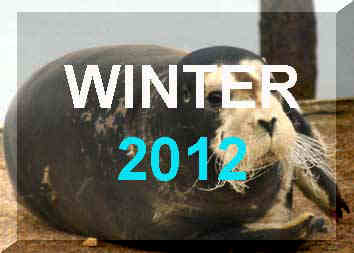


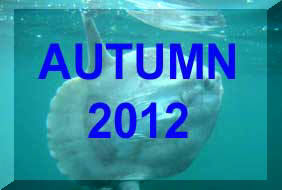

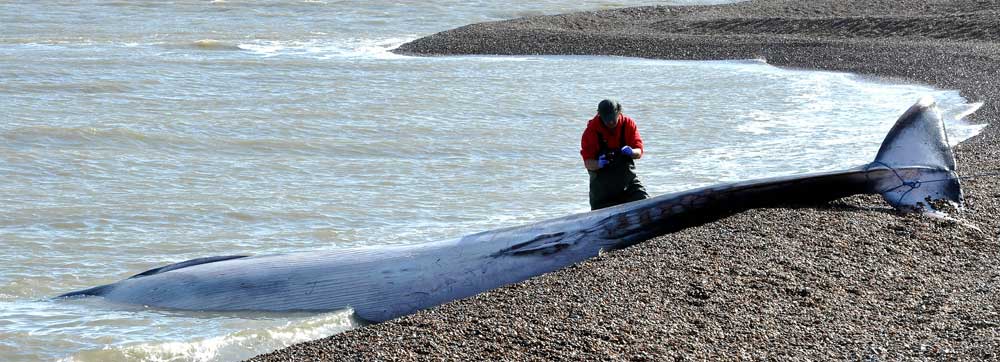


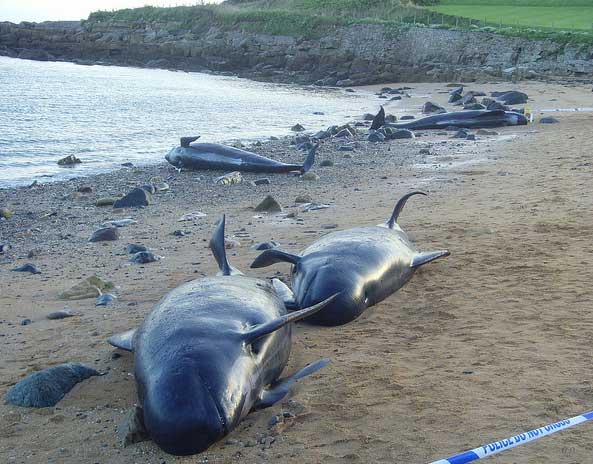
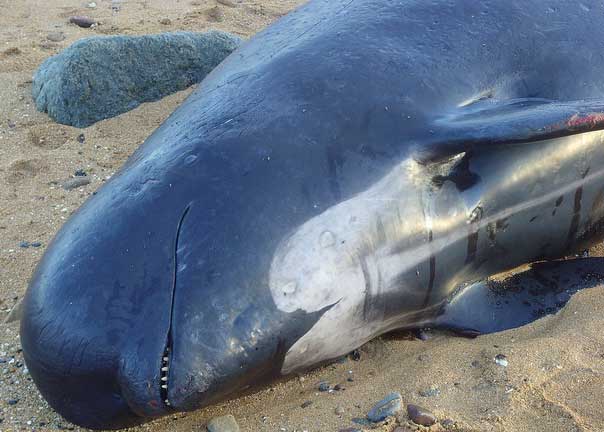





.jpg)
